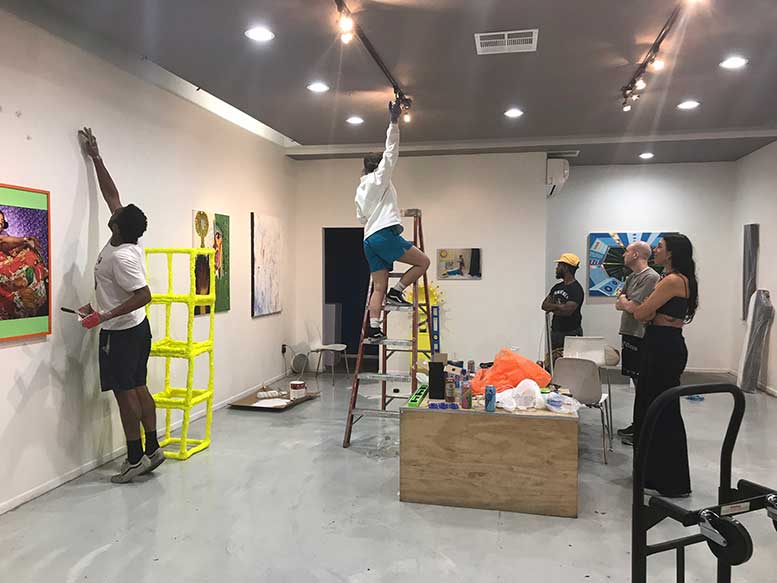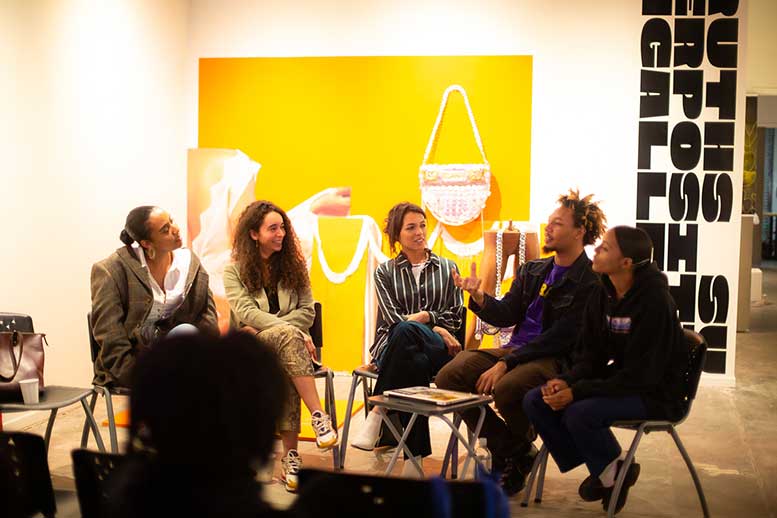Contemporary art & community
“I wanted to work in art but not contribute to the ways in which art objects can displace entire communities.”
– Storm Ascher
Storm Ascher, curator and founder Superposition Gallery, talks about providing artists and their communities alternative ways to participate and her socially conscious approach to contemporary art.

How did your tryst with art begin?
My family moved around a lot when I was growing up. I lived in different cities across the USA and I believe that is how my artistic vision became innate; recreating myself in new places, observing and questioning everything about my place in them and comparing myself to those who could really call a place ‘home’.
I was very active in the performing arts-singing, acting, dancing. Started photographing performances of my peers. This led to me wanting to be a part of creative direction. I worked at places like Nylon Magazine and Milk while pursuing my arts degree at School of Visual Arts, NY.

Let’s talk about your long-term vision. Would it be safe to say that Superposition Gallery is a step towards manifesting this vision?
My long term vision took root when I was studying art and city branding in Barcelona. A turning point was when I became conscious of the globally accepted gentrification tactics. These continue to be applied under the guise of art and culture. After moving to New York, this grew on me even more. Artists being continuously priced out of their own lofts and studios. And the expansion of the art districts in my hometown of Los Angeles and the resulting controversy. I wanted to work in art but not contribute to the ways in which art objects can displace entire communities. So far, after eleven pop up shows I feel that we have successfully given artists and their communities an alternative way to participate in the arts. There is always more to do, of course.

How do you describe yourself in the context of challenging people’s perspectives via your work?
The culture of pop ups has permeated almost every industry. Especially in times like the COVID pandemic, where everyone has to think about overhead costs and longevity; the pop up model is very disruptive to the brick and mortar model from a business perspective. I reduced my fixed costs by a lot. Instead of being stuck in a place, I get to pick hot markets wherever I want.
By owning one of the only twelve black owned art spaces in Los Angeles, I challenge the perspective of being a black woman who owns and runs a business. I want the perspective of how black people participate to change, not just if they’re participating at all or given opportunities.

What does your role at Superposition Gallery involve? How do you balance the contradicting elements of your work?
My roles at Superposition vary because I am the only person there. Sometimes, I invite guest curators or hire friends to help with things like promotional design, installation, etc. I’ve finally started to outsource these things so that I can focus on what I care most about which is the whole community coming together and seeing the work presented with respect. Curating an experience is the top priority, creating a story or world within a temporary space. I also see that as an extension of my own art practice.

How do you strike a balance between the contradicting motivations: commercial v/s creative? Do you outsource or handle the commercials yourself?
I am an artist myself, so it is impossible to just look at this solely from a commercial perspective. So I am more equipped naturally for the creative aspects of this endeavour. I am actively studying and practicing financial aspects of the art industry. This is to protect my artists and myself from being co-opted by blue chip organisations which may have had an easier start than I did. I’m about to graduate from the Sotheby’s Art Business program. This has helped me tremendously with levelling the playing field and understanding the legal and financial implications of contemporary art. I don’t want to outsource those aspects until I fully understand them myself.

How does your interaction with an artist evolve from the initial interface, to the working- involvement-relationship?
Many artists find me on Instagram or send me their work images to the gallery email. I’m not against looking at those. Sending unsolicited portfolios is something I was discouraged from, throughout my career. So I think subverting that taboo makes me respect them more for going for it.
Once I’m invested, the interactions take place over FaceTime . I get to know more about an artist and how they operate, both in life and in the studio. This has been really important in these times because of the lack of events to network and continue the conversation organically as I usually would. All my artist relationships are trust based. I look out for those that have loyalty and positivity in every aspect of their life because that will translate to our business relationship.

Future projects: What are you working on now? What should we look forward to?
Our 2 year anniversary is coming up in August; so I am doing a nomadic show traveling from New York to Los Angeles, provided I can travel.
I am also, now in talks with producers about documenting the process of putting together exhibitions in different cities and featuring the artists we work with and how they live their lives. Haven’t seen any docu-series or networks like that available, just as I didn’t see any gallery models like the one we started.
What were you working on when the lockdown was announced?
We had just installed our pop up show in South LA called Parallel Realities & Unpopular Truths curated by Mylo Mu and myself. We had to cancel the opening reception within hours and had to slowly figure out how to uninstall given the quarantine orders. Then the show was extended on our online platforms.

How has this affected your practice and plans?
This has actually levelled the playing field of access, given that we were also an online entity from the beginning and never had a permanent space. It made me realise my model could somewhat survive tumultuous times like these and that other galleries started to adapt as well.
For enquiries contact: storm [at] superpositiongallery [dot] com
Before you go – you might like to browse the Asian Curator curatorial archives . Contemporary art curators and international gallerists define their curatorial policies and share stories and insights about the inner runnings of the contemporary art world.












Add Comment